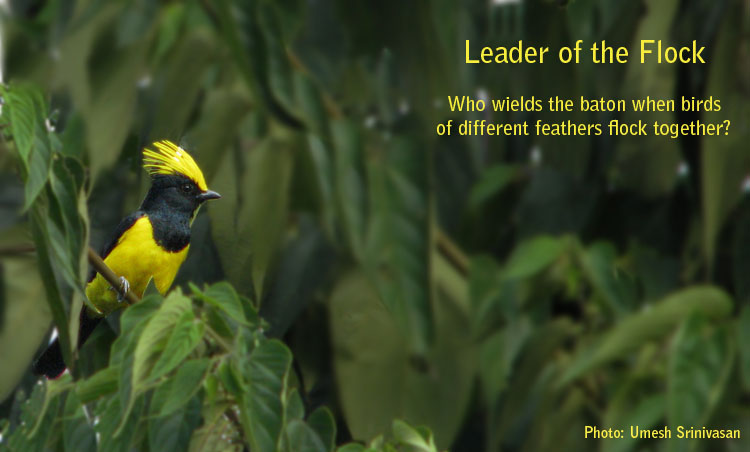Leader of the Flock

The Sultan Tit, a highly 'nuclear' species, is 'a real rowdy', say Umesh Srinivasan, main author of the paper. Namdapha National Park, Arunachal, India. Photo: Umesh. Edited: Geoff Hyde
A team of behavioral ecologists (Umesh Srinivasan, Rashid Raza and Suhel Quader) at NCBS Bangalore have now proposed a new perspective on the importance of different species in a multi-species animal group. Previous studies on multi-species groups have categorised the role of a particular species in a very binary and qualitative way, i.e. a species is rated either as ‘nuclear’ (species that maintains group; for birds, often considered to be those that are vocal or gregarious) or ‘attendant’ (species that follows a nuclear one). But in a paper recently published in the Journal of Animal Ecology, the NCBS teams proposes that nuclearity is a trait that is context-specific and that varies along a continuum (i.e. from most nuclear to least nuclear). The study, hence, establishes a hierarchy of nuclearity for the bird species - we have a nuclearity series of birds, just as the activity series of metals! The paper (which is online here) also presents a model that predicts leadership.
Multi-species associations are not just seen in birds - they are also found in animals from other kingdoms – fish, spiders, primates, cetaceans, etc. - but birds have the most complex associations, with as many as 20 species grouping together. It was this very diversity in the flocks that led Umesh Srinivasan, the principal author of the study, to question whether the simple binary breakdown was really the whole story. He wondered if this dichotomy of dividing the various species into nuclear or attendant is biologically realistic and representative of the inherent complex associations that exist between different species.. “While fixed species traits, such as being gregarious or foraging in a certain way, do determine the extent to which a species is nuclear, we still need an understanding of other factors, such as the species composition of the group, for a complete understanding of nuclearity”, comments Umesh.
Instead of characterising birds as nuclear or attendant based on informal judgments (i.e. birds acting more or less “like leaders”) the study decided to develop an objective measure of nuclearity. This would then be related back to qualitatively assessed fixed species traits. The authors studied 86 mixed species flocks that move within two rainforest niches - the understorey or the canopy - in the tropics of India. They defined the nuclearity of a species as the number of associations that species made with other species in the flock. The average strength of such associations was found to increase almost linearly with the number of associations - more nuclear birds had stronger associations with other species than did less nuclear ones.
Umesh’s new index of nuclearity immediately made it clear that species of birds do not fall into two neat groups, in terms of leadership; rather they fall along a nuclearity continuum. The existing leaders of a flock will defer to birds of a more dominant species if they join the group. On being asked the rationale behind choosing the number of inter-species associations in defining nuclearity, Umesh said, “We believe that species vary along a continuum in providing benefits to other participants in a flock. The greater is the benefit offered by a species, the higher are the number of other species that are likely to associate with that species.” Sounds convincing!
What is it that makes some species more likely to be leaders? Umesh found that while previous studies had an incomplete understanding of nuclearity, their ideas about the behavioral traits that determine leadership potential agreed with his study’s findings. His measure of nuclearity correlated well with two behavioral traits – gregariousness and foraging method.
The main novelty of the study is that it represents the first attempt to look beyond the role of fixed species traits, by quantitatively analyzing how flock dynamics respond to changes in flock composition. If researchers can define the continuum of species in any flock, they will then be able to predict the role of any one species in the flock, and how the dynamics of the flock as a whole will shift when one or more species exits or is removed (e.g. due to hunting). The authors expect their model to hold for mixed-species bird flocks worldwide and to be generally applicable to any multi-species animal group.
The study can hence predict which species would jump up the ladder in the nuclearity series of birds as conditions change, and wield the baton when birds of different feathers flock together.

Comments
It's always great to know
Hi Ish Thanks for the
The story is excellent! There
A well written article. An
Post new comment